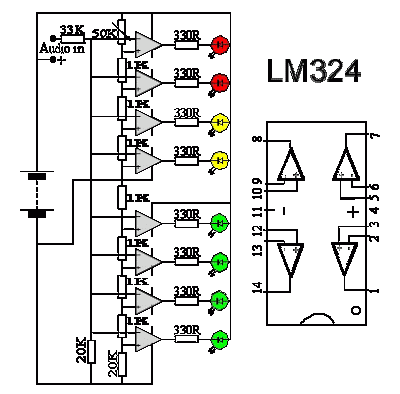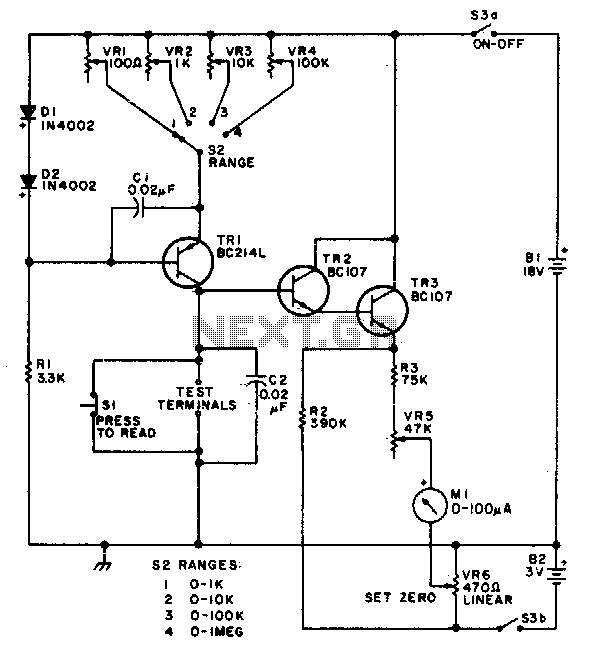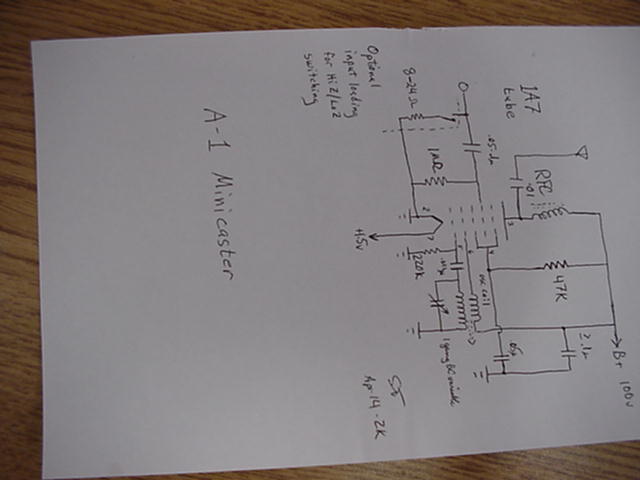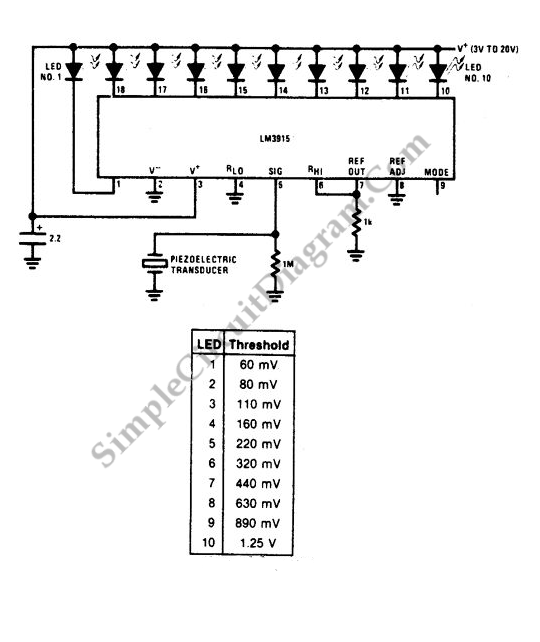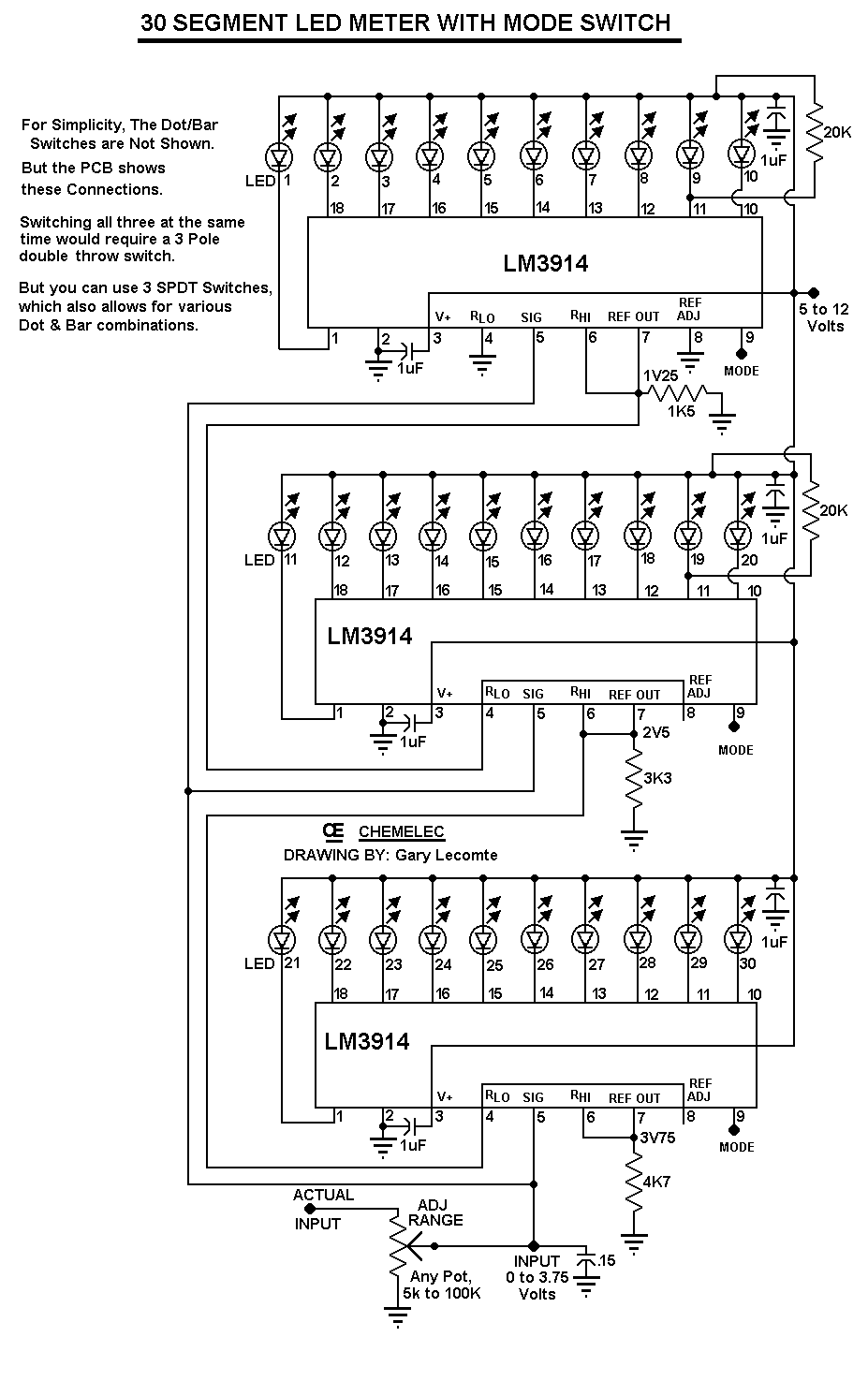
Lets to build many VU Meter circuits with LM3914
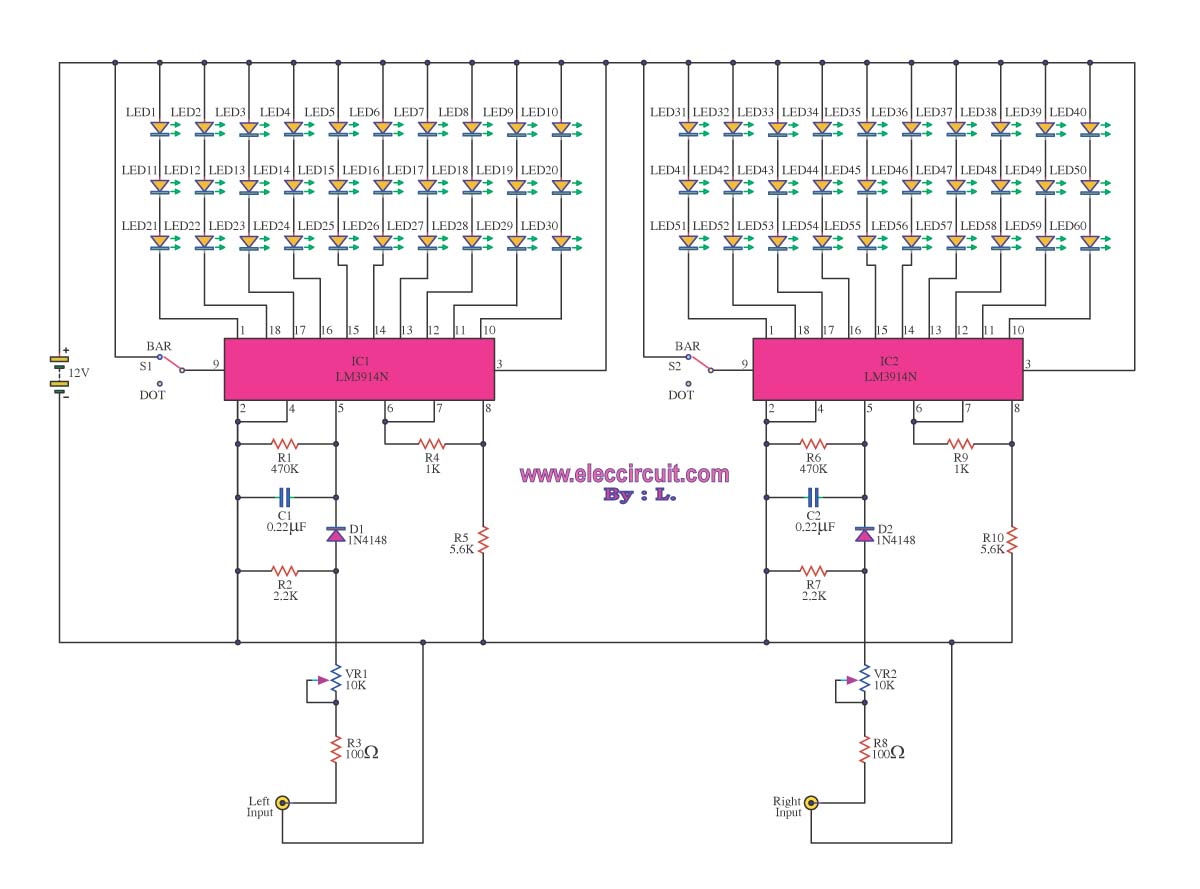
A VU meter is utilized to display the power level of audio signals and also serves as an aesthetic element. When purchasing a VU meter kit from an electronics store, options include assembling various parts independently or selecting a pre-assembled style. The LM3914 integrated circuit (IC) is commonly chosen for its convenience and versatility in modifications. This document outlines the assembly of a circuit using this IC. Additionally, the VU meter can be creatively employed for decorative purposes, such as flashing lights for a band performance or adorning a Christmas tree. The LM3914 circuit is widely recognized and features a voltage range advantage. The fourth pin of the IC is split, with the reference voltage on pin 6 being low, allowing for voltage division. When the power supply circuit is activated and the audio signal is received, the sound signal is directed through D1, which only transmits the positive portion of the signal. The C1 and R1 components serve as a smoothing filter for the signal. The light signal is then sent through R2 to the input pin 5 of the IC, which displays the signal starting from output pin 1 (LED1) to pin 10 (LED10). The display mode can be selected between bar and dot formats using switch S1. VR1 adjusts the reference voltage for the IC, while R3 limits the output current. If R3's value is low, LEDs 1-10 will shine brightly. This circuit utilizes the LM3914 and a BC109C transistor to indicate the audio signal level in decibels (dB) across six levels via an LED display, commonly referred to as a VU meter, suitable for stereo systems. The basic VU meter with 10 LEDs can monitor high signals, and a Q1-BC109 transistor can be added to amplify low-level signal inputs. Although this circuit is mono, a second unit can be constructed for stereo output. The design is straightforward, relying on a single integrated circuit, making it cost-effective. The circuit's operation begins with input through VR, which adjusts the signal strength. D1 removes the negative half of the signal, allowing only the positive half to activate Q1. The signal is then amplified through Q1 to pin 5 of IC1. The capacitor C1 introduces a delay, ensuring that the LED does not turn off immediately after the IC's output. The IC displays the voltage effect at pin 5 across the LED outputs (pins 1-19), adhering to standard voltage ranges. The circuit functions effectively, with R1 determining the current through the LEDs to prevent damage. The circuit should be connected to the speaker terminals, and R3 can be adjusted to 10k. The IC can display in two formats: bar (when pin 9 is powered) or dot (when pin 9 is floating). This circuit, often referred to as a VU meter, is user-friendly for beginners due to its simplicity and minimal components. The primary device, the LM3914N, effectively shows audio signal levels as either a bar or dot display. The behavior of IC1 and IC2 is similar, with R2, R3, and VR1 configured to divide the voltage appropriately before passing through D1 to pin 5. R1 and C1 ensure a delay for the input signal at pin 5, preventing immediate fade-out. Each IC's output connects to a series of LEDs, with current limited as needed.
The VU meter circuit based on the LM3914 is designed to visually represent audio levels, making it an essential tool for audio engineers and hobbyists alike. The circuit's simplicity allows for easy assembly, while the use of the LM3914 IC ensures reliable performance across various audio applications. The ability to select between bar and dot displays enhances its versatility, catering to different user preferences. Furthermore, the inclusion of a transistor for low-level signal amplification expands its usability, enabling the monitoring of quieter audio sources without sacrificing accuracy. This circuit can be integrated into various audio equipment, such as mixers, amplifiers, and home audio systems, providing a visual cue for audio levels and preventing distortion due to excessive signal levels. Proper calibration of components, particularly R1 and R3, is crucial for optimal LED performance and longevity, ensuring that the VU meter operates within safe parameters while delivering accurate visual feedback. Overall, the LM3914-based VU meter circuit serves as an invaluable addition to any audio setup, combining functionality with aesthetic appeal.A VU Meter is used to display the power level of the audio, it also is beautiful. When you go to the electronic equipment store to buy the VU meter kit, with the assembly various parts on their own or the style ready to use. Most of us are using the IC-LM3914, because it is convenient, easy to modify in many form. Today I assemble a the circuits that use this IC. Sometimes you are looking for ideas on this. For example: Flashing lights by the band, to decorate the Christmas tree, exotic, and unique. VU meter circuit is an IC number LM3914. This is a circuit that is commonly used standards. Within the integrated circuit LM3914 is a voltage range advantage. This is the fourth leg split. Reference voltage pin 6 is low, and the reference voltage divided up. When raising the power supply circuit and the signal came, the sound signal to be via D1 Optical Direct Fire only split the signal to positive The C1 and R1 signal smoothing filter. Then, light is sent through R2 to access the input pin 5 of IC by the IC to the display of the signal starts from the output pin 1 or LED1 contiguous to the leg 10 or LED10.
You can choose form of a display 2. is a bar display and the display. Select use the switch S1. VR1 which acts on the set voltage reference ICs and R3 of the output current limiting function. If the value at which R3 LED1-LED10 are very bright. This is Circuit LM3914 LED VU Meter. use IC1-LM3914 and Transistor BC109C, By circuit will show level of audio signal(power Music) is dB in six level by LED display or also known as VU-METER. for the stereo system. In this : VU meter 10 LED using LM3914 is basic it can monitor 10 led but use for high signal, when we add the Q1-BC109 at input section to boost up current for low level signal input.
As you see, Be mono circuit but if you would to need stereo, you are going to make only other one. It is Build easily because use the integrated circuit just one and the price is inexpensive. The detail is all, see in the circuit better. This is a simple light running circuit by music This circuit is not difficult, is MONO, with a few accessories. Can be connected to the output of a CD or cassette player Time. Operation of the circuit. Begins to be input via VR. The VR will function fine, signal strength coming. D1 will take disconnected hemisphere plus leaving only the signal hemisphere removed to activation of Q1.
Signal is extended through Q1 to pin 5 input of IC1. By C1 forward delay of the IC is not the LED (connected to the output. of IC1) off immediately. The IC IC1 is finished. The act shows the effect of the voltage at IC1 pin 5 of the display by the LED to pins 1-19 of the IC, which is within range. compared to a multiple voltage standard circuits. The circuit can operate effectively. In the R1 that it will determine the current flowing through the LED. To prevent LED damage. Use should be connected to the input of the circuit. To the speaker terminals, change the value of R3 is 10k and IC1 can choose to display two types Bar (Bar) when the pin 9 and a power source.
Dots (Dot) on 9-pin to float to drop. This circuit is another name for the VU meter. which often have a lot of equipment. Cause problems for people who start training. But this cycle is not much equipment. You can also choose, in the. Operation of the circuit. It is the primary device IC number LM3914N is ready to show the effects of pressure, as a bar or have a point. Behavior of IC1 and IC2 is similar circuit R2, R3, VR1 is connected in the manner divided voltage to the input to the voltage appropriate, through D1 to Pin 5.
by R1 and C1 are waiting delay. Input pin 5 not to fade away soon. When a signal to the output of each IC pin is connected to the 3-Series LED, to limit the flow. But if you want the L 🔗 External reference
The VU meter circuit based on the LM3914 is designed to visually represent audio levels, making it an essential tool for audio engineers and hobbyists alike. The circuit's simplicity allows for easy assembly, while the use of the LM3914 IC ensures reliable performance across various audio applications. The ability to select between bar and dot displays enhances its versatility, catering to different user preferences. Furthermore, the inclusion of a transistor for low-level signal amplification expands its usability, enabling the monitoring of quieter audio sources without sacrificing accuracy. This circuit can be integrated into various audio equipment, such as mixers, amplifiers, and home audio systems, providing a visual cue for audio levels and preventing distortion due to excessive signal levels. Proper calibration of components, particularly R1 and R3, is crucial for optimal LED performance and longevity, ensuring that the VU meter operates within safe parameters while delivering accurate visual feedback. Overall, the LM3914-based VU meter circuit serves as an invaluable addition to any audio setup, combining functionality with aesthetic appeal.A VU Meter is used to display the power level of the audio, it also is beautiful. When you go to the electronic equipment store to buy the VU meter kit, with the assembly various parts on their own or the style ready to use. Most of us are using the IC-LM3914, because it is convenient, easy to modify in many form. Today I assemble a the circuits that use this IC. Sometimes you are looking for ideas on this. For example: Flashing lights by the band, to decorate the Christmas tree, exotic, and unique. VU meter circuit is an IC number LM3914. This is a circuit that is commonly used standards. Within the integrated circuit LM3914 is a voltage range advantage. This is the fourth leg split. Reference voltage pin 6 is low, and the reference voltage divided up. When raising the power supply circuit and the signal came, the sound signal to be via D1 Optical Direct Fire only split the signal to positive The C1 and R1 signal smoothing filter. Then, light is sent through R2 to access the input pin 5 of IC by the IC to the display of the signal starts from the output pin 1 or LED1 contiguous to the leg 10 or LED10.
You can choose form of a display 2. is a bar display and the display. Select use the switch S1. VR1 which acts on the set voltage reference ICs and R3 of the output current limiting function. If the value at which R3 LED1-LED10 are very bright. This is Circuit LM3914 LED VU Meter. use IC1-LM3914 and Transistor BC109C, By circuit will show level of audio signal(power Music) is dB in six level by LED display or also known as VU-METER. for the stereo system. In this : VU meter 10 LED using LM3914 is basic it can monitor 10 led but use for high signal, when we add the Q1-BC109 at input section to boost up current for low level signal input.
As you see, Be mono circuit but if you would to need stereo, you are going to make only other one. It is Build easily because use the integrated circuit just one and the price is inexpensive. The detail is all, see in the circuit better. This is a simple light running circuit by music This circuit is not difficult, is MONO, with a few accessories. Can be connected to the output of a CD or cassette player Time. Operation of the circuit. Begins to be input via VR. The VR will function fine, signal strength coming. D1 will take disconnected hemisphere plus leaving only the signal hemisphere removed to activation of Q1.
Signal is extended through Q1 to pin 5 input of IC1. By C1 forward delay of the IC is not the LED (connected to the output. of IC1) off immediately. The IC IC1 is finished. The act shows the effect of the voltage at IC1 pin 5 of the display by the LED to pins 1-19 of the IC, which is within range. compared to a multiple voltage standard circuits. The circuit can operate effectively. In the R1 that it will determine the current flowing through the LED. To prevent LED damage. Use should be connected to the input of the circuit. To the speaker terminals, change the value of R3 is 10k and IC1 can choose to display two types Bar (Bar) when the pin 9 and a power source.
Dots (Dot) on 9-pin to float to drop. This circuit is another name for the VU meter. which often have a lot of equipment. Cause problems for people who start training. But this cycle is not much equipment. You can also choose, in the. Operation of the circuit. It is the primary device IC number LM3914N is ready to show the effects of pressure, as a bar or have a point. Behavior of IC1 and IC2 is similar circuit R2, R3, VR1 is connected in the manner divided voltage to the input to the voltage appropriate, through D1 to Pin 5.
by R1 and C1 are waiting delay. Input pin 5 not to fade away soon. When a signal to the output of each IC pin is connected to the 3-Series LED, to limit the flow. But if you want the L 🔗 External reference
Warning: include(partials/cookie-banner.php): Failed to open stream: Permission denied in /var/www/html/nextgr/view-circuit.php on line 713
Warning: include(): Failed opening 'partials/cookie-banner.php' for inclusion (include_path='.:/usr/share/php') in /var/www/html/nextgr/view-circuit.php on line 713

